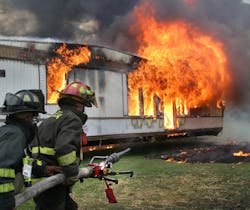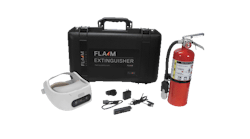Firefighting Doing More With Less
An oxymoron is a figure of speech that combines contradictory terms. Some examples are "authentic replica," "boneless ribs" and "fresh prunes."
Two of my favorites are "free with purchase" and "doing more with less." In the first instance, we must assume that the "free" item's cost is buried in there somewhere. Common sense tells us that it is difficult, if not outright impossible to do more with less, but fortunately, we in the fire service have a tendency to somehow make it work.
Take, for example the need to flow water in quantities in excess of what can be safely delivered through hand-held hoselines. Couple this need with minimal staffing and you face the dilemma of either letting the building burn down to a size that can be handled with the water you are flowing, or call in the heavy artillery designed to apply the needed water in the proper quantity.
An apparatus-mounted deck gun is a good example of heavy artillery, but it does have some limitations. If the pumper is not positioned properly, the stream cannot be brought to bear where it is needed.
For example, if a fully-involved alley garage is spreading to the structures next to it, and the engine is on the street in front of the house, the deck gun has no hope of getting a shot at the blaze. Some deck guns are designed to be disconnected from their supply pipes and attached to a ground base, but the problem is that maneuver this requires at least two firefighters, plus others needed to stretch the line to supply the device.
The answer to this dilemma that proves that indeed, you can do more with less, is the attack monitor. The first was the Blitzfire was introduced by Task Force Tips, followed by Akron's Mercury, Elkhart's RAM, Crestar's Personal Monitor, and others.
While a large monitor can apply 1,250 gpms or more, these smaller units are designed to provide streams in the 300 to 500-gpm range. In addition, they have shutoffs to allow them to be used to "hit and move" at a fast-spreading fire, something the big monitors don't have.
- You can see Capt. Dave Fornell live when he present "What’s at the End of your Hose line? and "Increasing your initial attack Firepower" at the Ohio Fire & EMS Expo on Sept. 21.
They weigh about the same as a brass playpipe nozzle and can be easily mounted on the tailboard or below the hose bed of an engine, or even packed on a skid load.
The best news is that one firefighter can safely flow that 500-gpm practically any place it is needed on the fireground. And, their cost is much less than a conventional ground monitor. If conditions dictate, they can be left in place flowing while firefighters move to safer ground.
All manufacturers offer small, high-volume fixed and automatic combination nozzles specifically designed for their attack monitors. While stacked smooth-bore tips are also common, keep in mind that the standard outboard tip on most assemblies is only a 1-inch that flows about 200 gpms. You might want to remove it and go for the 1 1/4-inch tip that can provide great streams from 328 gpms at 50 psi to 460 gpms at 100-psi. An added advantage is that the tip will have standard 1 1/2-inch threads on the end so smaller hose can be attached for overhaul.
With most manufacturer's stacks, running with the 1 1/4-inch tip outboard provides great flow flexibility and if more water is needed, it can be removed and the 1 1/2-inch tip underneath can provide the 500-gpm flow.
All these monitors are supplied with a nylon strap tether that should be used to secure the gun to a substantial object, such as a tree or power pole, or its looped supply line.
Remember that these devices are not designed to replace conventional monitors and deck guns capable of 700 gpms-plus flows. They are precision tools designed to allow a staffing-challenged crew to safely apply 300 to 500 gpms in the initial stages of a fire. In real-life situations however, you might find that 500-GPM in the right place is just the ticket you need to safely knock down a large fire.









